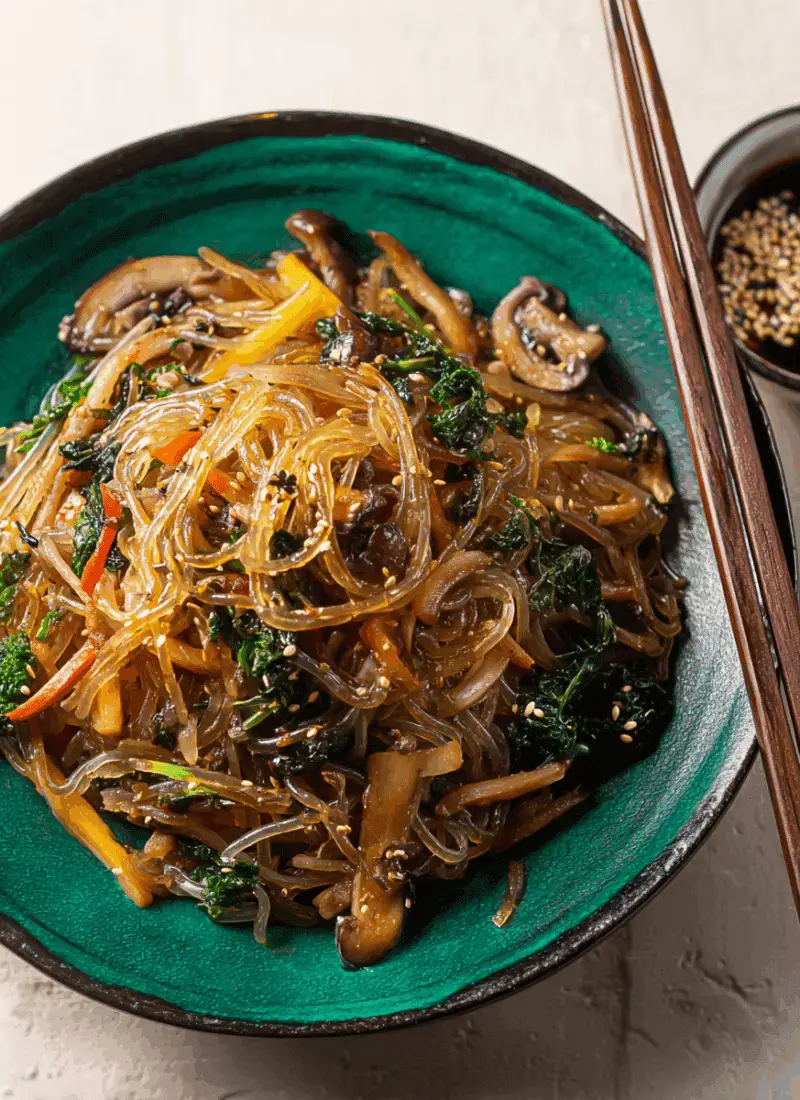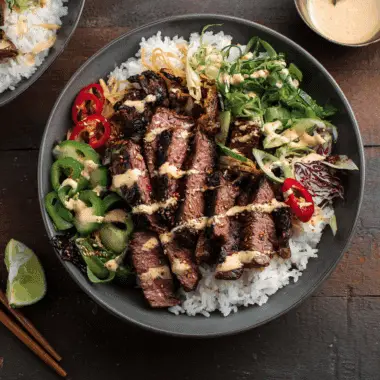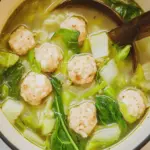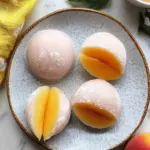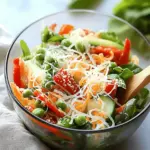Sweet and savory, Japchae is a beloved Korean dish known for its glassy sweet potato noodles stir-fried with colorful vegetables and a sesame-soy glaze. This dish perfectly balances texture and taste, offering chewy noodles, crisp-tender vegetables, and a subtle nuttiness from sesame oil and seeds.
Ideal for gatherings or everyday meals, Japchae is naturally gluten-free (when made with tamari or gluten-free soy sauce) and easily adaptable to vegetarian or vegan diets. It can be served warm or at room temperature, making it perfect for meal prepping, picnics, or bento boxes. This dish brings Korean flavors to your kitchen with ease and elegance.
Full Recipe
Ingredients:
-
6 oz (170g) sweet potato glass noodles (dangmyeon)
-
1 tablespoon sesame oil
-
2 tablespoons soy sauce
-
1 tablespoon sugar
-
2 teaspoons sesame seeds
-
1 small carrot, julienned
-
1/2 onion, thinly sliced
-
1/2 red bell pepper, thinly sliced
-
2 cups spinach
-
3-4 shiitake mushrooms, thinly sliced (rehydrated if dried)
-
2 cloves garlic, minced
-
1 egg, beaten (optional, for garnish)
-
Salt and pepper to taste
-
Cooking oil as needed
Directions:
-
Boil water in a large pot. Add glass noodles and cook for 6–7 minutes until soft but firm. Drain, rinse under cold water, and cut into shorter strands with kitchen scissors. Drizzle 1 tsp sesame oil to prevent sticking. Set aside.
-
In a skillet over medium heat, add oil and sauté carrots for 1–2 minutes until slightly softened. Remove and set aside.
-
Repeat the same for onion, bell pepper, mushrooms, and spinach separately, lightly seasoning each with a pinch of salt.
-
In a large pan or wok, heat a bit of oil. Add minced garlic and stir-fry briefly until fragrant.
-
Add all the sautéed vegetables and noodles to the pan. Pour in soy sauce and sugar. Toss everything gently using tongs for even coating.
-
Add sesame seeds and remaining sesame oil. Stir and cook for another 1–2 minutes.
-
If using egg garnish, cook the beaten egg in a thin layer, roll it, and slice into ribbons to top the japchae.
-
Serve warm or at room temperature.
Prep Time: 20 minutes | Cooking Time: 15 minutes | Total Time: 35 minutes
Kcal: 280 kcal | Servings: 4 servings
What Is Japchae?
Japchae (잡채), pronounced “jap-chay”, is a traditional Korean dish featuring stir-fried glass noodles made from sweet potato starch, combined with a variety of colorful vegetables, and seasoned with a savory-sweet blend of soy sauce and sesame oil. It’s often garnished with sesame seeds, and sometimes topped with thinly sliced egg ribbons or beef, though vegetarian versions are just as popular.
Unlike typical stir-fry dishes, Japchae’s glass noodles (known as dangmyeon) are prized for their chewy texture and their unique ability to absorb the bold flavors of the sauce without becoming soggy. The dish is typically served either warm or at room temperature and is a staple at Korean celebrations, family gatherings, and even everyday meals.
A Brief History of Japchae
Japchae originated in the early 17th century during the Joseon Dynasty. It was first created as a royal court dish and presented to King Gwanghaegun. The story goes that one of the king’s lieutenants, Yi Chung, created a savory mixture of vegetables and mushrooms, which impressed the king so much that the dish became a favorite.
Interestingly, the original version of Japchae did not contain noodles at all. The sweet potato glass noodles were only introduced to the dish later on, sometime during the 20th century, when Korea began producing sweet potato starch in large quantities. This addition transformed the dish into what we now know as the modern version of Japchae.
Over the centuries, Japchae has evolved from a dish for royalty to a beloved comfort food for people across Korea and around the world.
Cultural Significance of Japchae in Korea
Japchae holds a special place in Korean cuisine and culture. It is considered one of the “banchan” (side dishes) commonly served during festive holidays such as Lunar New Year (Seollal) and Harvest Festival (Chuseok). On these occasions, it’s a must-have dish on the table and symbolizes celebration, good fortune, and togetherness.
Its vibrant colors, variety of textures, and balanced flavor make Japchae not only delicious but also visually appealing, which aligns with the Korean philosophy of harmony in food. In traditional Korean cuisine, a balance of five colors (green, red, yellow, white, and black) is believed to promote good health. Japchae often includes ingredients that represent all five colors.
Beyond holidays, Japchae is often included in lunchboxes (dosirak), served at weddings, birthdays, and other important gatherings. It represents a perfect balance between indulgence and health, which is a defining characteristic of Korean food.
Health Benefits of Japchae
One of Japchae’s greatest strengths is its nutritional profile. The dish combines fiber-rich vegetables with sweet potato noodles that are naturally gluten-free, making it an excellent option for those with gluten sensitivities.
Here are some notable health benefits of Japchae:
-
Low in fat: The dish is sautéed with a minimal amount of oil, mainly sesame oil, which is rich in healthy fats and antioxidants.
-
Rich in fiber: The various vegetables such as spinach, bell peppers, carrots, and mushrooms provide essential vitamins, minerals, and dietary fiber.
-
Plant-based proteins: In vegetarian or vegan versions of Japchae, the combination of vegetables and sesame seeds contributes a small but beneficial amount of plant-based protein.
-
Gluten-free: When prepared with gluten-free soy sauce or tamari, Japchae becomes a naturally gluten-free dish, perfect for those following a celiac or gluten-free diet.
Japchae is also very filling due to the starch in the noodles and the fiber in the vegetables, making it a satisfying yet light meal that doesn’t leave you feeling sluggish.
Japchae Around the World
As Korean cuisine gains popularity globally through the Korean Wave (Hallyu), Japchae has become a go-to dish for those new to Korean food. It’s often listed on menus in Korean restaurants internationally and is a common feature at Korean BBQ restaurants.
Food bloggers and influencers have helped make Japchae more accessible by showcasing simple home-cooked versions, adding plant-based variations, and even creating fusion versions like Japchae spring rolls, Japchae salad bowls, or Japchae with tofu and kimchi.
Its versatility makes it a favorite for home cooks who want to prepare something exotic but not overly complicated. Japchae has a wide appeal, from foodies who love bold flavors to picky eaters who prefer milder dishes.
How Japchae Differs From Other Noodle Dishes
It’s easy to compare Japchae to other Asian noodle stir-fries, but several elements make it stand out:
-
Type of noodles: Unlike egg noodles or wheat-based noodles used in many Chinese and Southeast Asian stir-fries, Japchae uses sweet potato starch noodles that are translucent and have a unique chewy texture.
-
Flavor profile: Japchae is both sweet and savory, a flavor combination that’s not as common in Western or even many Asian noodle dishes.
-
Balance and simplicity: Japchae avoids overpowering sauces or excessive oil. It emphasizes balance—light seasoning, gentle stir-frying, and fresh ingredients.
This makes Japchae a healthier, more subtle noodle dish compared to some oil-heavy or intensely spicy counterparts in other cuisines.
Tips for Serving Japchae
Japchae is one of those dishes that can be adapted for any occasion. Here are a few ideas on how to serve it:
-
Party Platter: Serve it in a large dish garnished with sesame seeds and egg ribbons for potlucks or celebrations. It holds well at room temperature, making it ideal for buffet-style meals.
-
Main Dish: Serve a generous portion alongside kimchi and a light soup. You can add marinated beef (bulgogi) or tofu for extra protein.
-
Side Dish: In Korea, Japchae is often part of a larger spread of side dishes (banchan). A smaller serving complements grilled meats, stews, or rice dishes.
-
Meal Prep: Japchae stores well in the fridge for up to 3–4 days and can be enjoyed cold or gently reheated. It’s perfect for work lunches or quick weeknight dinners.
Popular Variations of Japchae
While the classic version of Japchae is made with vegetables and occasionally beef or egg, there are many ways to adapt the dish:
-
Vegan Japchae: Simply omit any animal-based ingredients and load up on vegetables. Use tamari or gluten-free soy sauce for a 100% vegan and gluten-free option.
-
Spicy Japchae: Add Korean gochugaru (chili flakes) or a spoonful of gochujang (Korean chili paste) for some heat.
-
Seafood Japchae: Incorporate shrimp or squid for a pescatarian-friendly version.
-
Fusion Japchae: Use the Japchae noodles and flavor base but serve it cold as a salad or wrap it in lettuce with a dash of ssamjang sauce.
Why Japchae Deserves a Spot in Your Regular Meal Rotation
Japchae is the kind of recipe that grows on you. It offers comfort without being heavy, it’s packed with nutrients, and it’s naturally beautiful on a plate. Whether you’re new to Korean cuisine or a longtime fan, Japchae is a dish you’ll return to again and again.
It’s also a great gateway recipe into the world of Korean cooking. Once you master the art of balancing the flavors in Japchae, you’ll likely feel more confident exploring other Korean dishes like bibimbap, tteokbokki, or kimchi stew.
It’s forgiving, customizable, and always crowd-pleasing.
Conclusion
Japchae is more than just a noodle dish—it’s a reflection of Korea’s deep-rooted food culture, which values balance, nutrition, and harmony. From its royal origins to its place in modern kitchens around the globe, Japchae has proven to be timeless.
Its chewy glass noodles, bright vegetables, and savory-sweet seasoning make it a joy to eat and a breeze to adapt to different diets and tastes. Whether served during holidays or as a weeknight dinner, Japchae never fails to deliver comfort and flavor in every bite.
By incorporating Japchae into your cooking repertoire, you’re not just enjoying a delicious dish—you’re taking part in a cultural tradition that celebrates family, wellness, and shared joy around the table.

